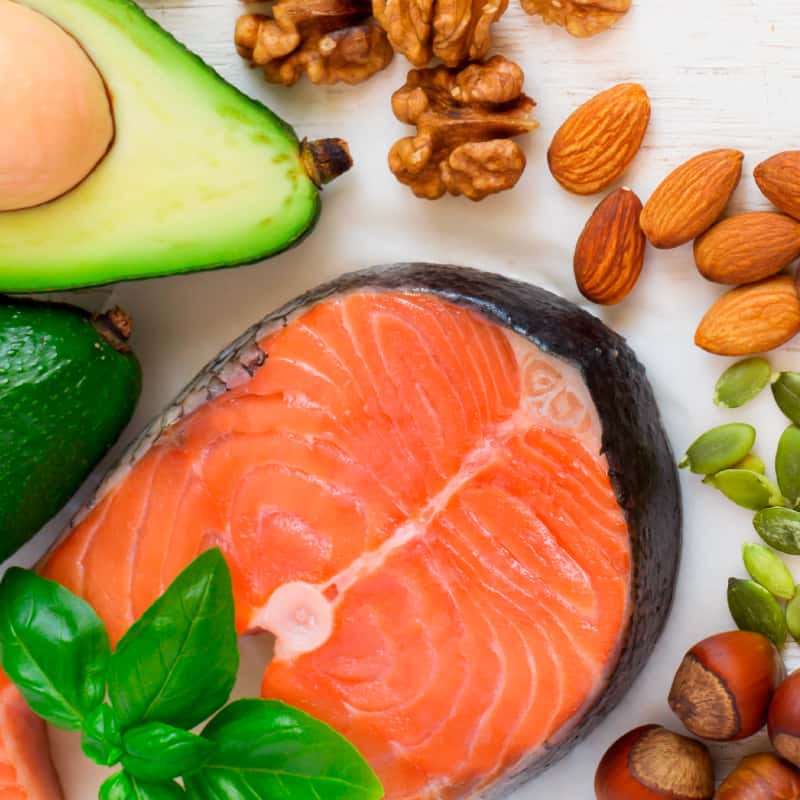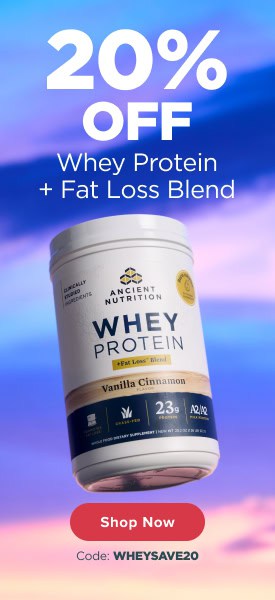This Dr. Axe content is medically reviewed or fact checked to ensure factually accurate information.
With strict editorial sourcing guidelines, we only link to academic research institutions, reputable media sites and, when research is available, medically peer-reviewed studies. Note that the numbers in parentheses (1, 2, etc.) are clickable links to these studies.
The information in our articles is NOT intended to replace a one-on-one relationship with a qualified health care professional and is not intended as medical advice.
This article is based on scientific evidence, written by experts and fact checked by our trained editorial staff. Note that the numbers in parentheses (1, 2, etc.) are clickable links to medically peer-reviewed studies.
Our team includes licensed nutritionists and dietitians, certified health education specialists, as well as certified strength and conditioning specialists, personal trainers and corrective exercise specialists. Our team aims to be not only thorough with its research, but also objective and unbiased.
The information in our articles is NOT intended to replace a one-on-one relationship with a qualified health care professional and is not intended as medical advice.
What Is Xanthan Gum? Is It Healthy?
September 9, 2023

Have you ever heard of xanthan gum? There is lots of conflicting information out there about this common food additive, which can make it difficult to decipher whether or not you should consume it.
You’ll read everything describing xanthan gum as a “natural” health food to being a known carcinogen. So what is xanthan gum, and what is the truth behind this mysterious ingredient that seem to be in everything today?
What Is Xanthan Gum?
It is a very interesting man-made ingredient.
What’s xanthan gum structure like? It’s considered a heteropolysaccharide, which means it contains two or more different monosaccharide units.
What is xanthan gum made out of? Actually the way that xanthan gum is manufactured is quite fascinating:
- First, it is produced when glucose, sucrose or lactose is fermented by the bacteria Xanthomonas campestris.
- Then, it is precipitated (made into a solid) by isopropyl alcohol.
- After being dried, it is ground into fine powder so it can be added to liquid to form gum.
While you may often see xanthan gum in food products, there are also many industrial xanthan gum uses. Because it is an effective “all natural” emulsifier, it’s considered a non-hazardous additive for a wide range of brines, drilling and fracturing fluids.
Is xanthan gum keto-friendly? Yes, it’s typically considered acceptable on a keto diet.
Is xanthan gum vegan? Sometimes it may be safe for vegans, but other times it may be created using whey so if you’re vegan it’s important to check on how it was made.
Xanthan Gum vs. Guar Gum
Xanthan gum is a guar gum substitute and vice versa. If you’re comparing guar gum vs. xanthan gum, guar gum is also used as a thickening and stabilizing agent in many common products.
Both are commonly added to flour mixes to add structure to baked goods. If you’re wondering how to use xanthan gum and guar gum, some sources say that guar works better in cold food, such as ice cream, while xanthan is better in baked goods.
Both xanthan and guar gum are gluten-free and often used in place of gluten.
Where to Find It
What is xanthan gum used for? Xanthan gum can found in such a wide variety of products, from food to cosmetics to medicines.
What does xanthan gum do? Produced by plant-pathogenic bacterium, xanthan gum is widely used as a thickening and stabilizing agent in a wide variety of food and industrial products. When gluten-free flours are used, xanthan gum also helps starches combine in desirable way.
Today it is commonly used in:
- Supplements
- Cosmetics
- Baked goods and pastry fillings
- Ice cream and sherbet
- Industrial products
- Jams, jellies and sauces
- Lotions
- Medicines
- Pudding
- Salad dressings
- Toothpastes
- Yogurt
Benefits
What is xanthan gum good for? While very few in number, some research studies have actually uncovered that xanthan gum may have substantial health benefits.
According to a 2009 article published in the journal International Immunopharmacology, for example, xanthan gum was shown to have cancer-fighting properties. This study evaluated the oral administration of xanthan gum and discovered that it “significantly retarded tumor growth and prolonged survival” of mice inoculated with melanoma cells.
Xanthan gum-based thickeners were also fairly recently found to help oropharyngeal dysphagia patients swallow because of increased viscosity. This is a condition in which people have a difficulty emptying food into the esophagus because of abnormalities in muscle or nerves.
Common in stroke victims, this use can help people considerably because it can aid aspiration. Interestingly, this increased viscosity can help reduce blood sugar spikes when xanthan gum is mixed with fruit juice.
In addition to these few studies, some internet sources claim that xanthan gum is good for the skin and hair as well.
Is It Safe?
It’s generally agreed upon in the scientific community that it is safe to consume up to 15 grams of xanthan gum per day. As described by an article published in the British Journal of Nutrition, it can cause “significant increases in stool output, frequency of defecation and flatulence” in humans consistently consuming 15 or more grams every day.
To give a little context, many protein powder dietary supplements use xanthan gum for its ability to add texture, but one serving of these usually contains less than half a gram of xanthan gum. The amount used in food products is also generally small.
To produce xanthan gum, manufacturers sometimes use common food allergens, including corn, soy, wheat and dairy products. So if you have an allergy to one or more of these, then you may need to avoid xanthan gum and products that contain it unless you can figure out how the gum was made.
Don’t be afraid to ask a manufacturer, “What is xanthan gum made of in your product?”
Substitute Options
Xanthan gum is marketed as a plant-based alternative to gluten as a binding agent in baking. There are a few xanthan gum substitutes you may want to try, though, if you’re interested in expanding your culinary skills with creative emulsifiers.
1. Psyllium Husk
According to an article published in the journal Food Research International, “Psyllium, besides being an excellent source of natural soluble fiber, has been widely recognized for its cholesterol-lowering effect and insulin sensitivity improvement capacity.”
Sold widely as a dietary fiber supplement, Iraqi researchers have actually proven that psyllium fiber is an effective alternative to gluten. Because soluble fibers become gelatinous and sticky in water, they discovered that by simply “adding up to 5 percent of psyllium can improve the baking characteristics of bread.”
However, other sources claim that you should use up to 10 percent because higher additions yield a softer crumb after testing storage periods up to four days. As would be expected, you’ll either need to add some water or increase the liquid content of your recipe to compensate for the water-absorbing fiber.
There’s no hard-fast rule, but it’s better to experiment and let your dough or batter sit for a few minutes to give the psyllium a chance to gelatinize. Then, you can add the right amount of liquid to get the consistency that you’re looking for.
2. Chia Seeds
Another great xanthan gum substitute is chia. Very similar to psyllium, chia seeds gelatinize rather quickly and contain a large amount of soluble fiber.
They have quickly become one of America’s favorite superfoods because they are nutrient-dense and packed with energy. The key to chia’s health success is that it contains a very favorable 3:1 omega-3 to omega-6 fatty acid ratio, which has been shown to help suppress inflammation — one of the primary causes of chronic disease today.
When added to liquid, it forms a gel-like substance that can improve the overall structure of baked goods very nicely. Because it retains water, it can be an effective solution to prevent your gluten-free breads and goodies from drying out too soon as well, which unfortunately happens all too often.
3. Flaxseeds
Known for being one of nature’s richest omega-3 fatty acid sources, flaxseeds have been used for literally thousands of years in breads and various food items. The health benefits of flax have taken the natural health world by storm because they have been linked to helping people with obesity, high cholesterol and even cancer.
When ground into a fine powder, flaxseed acts as an effective binding agent and can easily replace the gooey gluten effect that bakers are looking for. It is important to note that whole flaxseeds do not have the same effect.
You must break the hard outer shell to enjoy its binding benefits. Simply add some ground flax to boiling water to form a thick paste that can be used in any gluten-free flour mixture.
4. Gelatin
Another substitute for xanthan gum is gelatin. Gelatin is the breakdown of collagen and has been used for a variety of health conditions since ancient times. It can help ease food allergies, sooth food sensitivities, and is extremely effective at promoting healthy bacteria (probiotic) balance and growth.
The Weston A Price Foundation describes that, “… prior to the mid 20th century, doctors recommended the addition of glycine-rich gelatin to the homemade infant formulas that were used when breast feeding was not possible.”
Like ground flaxseed, gelatin is a wonderful gluten and xanthan gum thickener alternative. Simply add with some water to get a gooey mixture that you’re looking for with your baked goods.
5. Agar Agar
Because gelatin is an animal product, it is not suitable for most vegetarians and definitely not for vegans. The solution to this problem is agar agar, a plant-based gelatin substitute.
The Japanese are known to use agar to lose weight because of its bulking effect, and its healing benefits reach beyond that of treating constipation and diabetes.
Made from seaweed, agar agar is flavorless and acts a fast thickening and food-stabilizing agent. Mix with water like you would with gelatin, and you’ll get a gel-like substance to help give you that gooey, bread-like texture.
Final Thoughts
- You can find xanthan gum in many food, cosmetic and industrial products.
- It is a polysaccharide (a type of sugar) made through a process of fermentation from a bacteria called Xanthomonas campestris.
- It’s also marketed as a plant-based alternative to gluten as a binding agent in baking.
- Is xanthan gum safe? It’s generally considered safe as long as you don’t exceed 15 grams per day.
- If you come across xanthan gum recipes, you now know that you have other healthy options to use as a substitute if you’d like, including psyllium fiber, gelatin, chia seeds, flaxseeds and agar agar.










